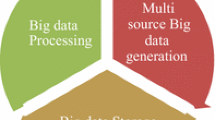Abstract
Frequent pattern mining discovers sets of items that frequently appear together in a transactional database; these can serve valuable economic and research purposes. However, if the database contains sensitive data (e.g., user behavior records, electronic health records), directly releasing the discovered frequent patterns with support counts will carry significant risk to the privacy of individuals. In this paper, we study the problem of how to accurately find the top-k frequent patterns with noisy support counts on transactional databases while satisfying differential privacy. We propose an algorithm, called differentially private frequent pattern (DFP-Growth), that integrates a Laplace mechanism and an exponential mechanism to avoid privacy leakage. We theoretically prove that the proposed method is (λ, δ)-useful and differentially private. To boost the accuracy of the returned noisy support counts, we take consistency constraints into account to conduct constrained inference in the post-processing step. Extensive experiments, using several real datasets, confirm that our algorithm generates highly accurate noisy support counts and top-k frequent patterns.
Similar content being viewed by others
References
Agrawal R, Srikant R. Fast algorithms for mining association rules in large databases. In: Proceedings of the 20th International Conference on Very Large Data Bases. 1994, 487–499
Atzori M, Bonchi F, Giannotti F, Pedreschi D. Anonymity preserving pattern discovery. Very Large Data Bases Journal, 2008, 17(4): 703–727
Xu Y, Wang K, Fu A, Yu P S. Anonymizing Transaction Databases for Publication. In: Proceedings of the 14th ACM SIGKDD International Conference on Knowledge Discovery and Data Mining. 2008, 767–775
Ganta S R, Kasiviswanathan S P, Smith A. Composition attacks and auxiliary information in data privacy. In: Proceedings of the 14th ACM SIGKDD International Conference on Knowledge Discovery and Data Mining. 2008, 265–273
Wong R C W, Fu A, Wang K, Yu P S, Pei J. Can the utility of anonymized data be used for privacy breaches. ACM Transaction on Knowledge Discovery from Data, 2011, 5(3):16
Dwork C. Differential privacy. In: Proceedings of the 33th Colloquium on Automata, Languages and Programming. 2006, 1–12
Bhaskar R, Laxman S, Smith A, Thakurta A. Discovering frequent patterns in sensitive data. In: Proceedings of the 16th ACM SIGKDD International Conference on Knowledge Discovery and Data Mining. 2010, 503–512
Li N, Qardaji W, Su D, Cao J. PrivBasis: frequent item set mining with differential privacy. Very Large Data Bases Endowment, 2012, 5(11): 1340–1351
Han J, Pei J, Yin Y, Mao R. Mining frequent patterns without candidate generation: a frequent-pattern tree approach. Data Mining and Knowledge Discovery, 2004, 8(1): 53–87
Dwork C, McSherry F, Smith A. Calibrating noise to sensitivity in private data analysis. In: Proceedings of the 3rd Theory of Cryptography Conference. 2006, 265–284
Hay M, Rastogi V, Miklau G, Suciu D. Boosting the accuracy of differentially private histogram through consistency. Very Large Data Bases Endowment, 2010, 3(1): 1021–1032
Chen R, Mohammed N, Fung B C M, Desai B C, Xiong L. Publishing set-valued data via differential privacy. Very Large Data Bases Endowment, 2011, 4(11): 1087–1098
Götz M, Machanavajjhala A, Wang G, Xiao X, Gehrke J. Publishing search logs-a comparative study of privacy guarantees. IEEE Transaction Knowledge and Data Engineering, 2012, 24(3): 520–532
McSherry F, Mironov I. Differentially private recommender systems: building privacy into the Netflix prize contenders. In: Proceedings of the 15th ACM SIGKDD International Conference on Knowledge Discovery and Data Mining. 2009, 627–636
Ding B, Winslett M, Han J, Li Z. Differentially private data cubes: optimizing noise sources and consistency. In: Proceedings of the 31th International Conference on Management of Data. 2011, 217–228
Friedman A, Schuster A. Data mining with differential privacy. In: Proceedings of the 16th ACM SIGKDD International Conference on Knowledge Discovery and Data Mining. 2010, 493–502
Mohammed N, Chen R, Fung B C M, Yu P S. Differentially private data release for data mining. In: Proceedings of the 17th ACM SIGKDD International Conference on Knowledge Discovery and Data Mining. 2011, 493–501
Chen R, Fung B C M, Desai B C, Sossou N M. Differentially private transit data publication: a case study on the Montreal transportation system. In: Proceedings of the 18th ACM SIGKDD International Conference on Knowledge Discovery and Data Mining. 2012, 213–221
Terrovitis M, Mamoulis N, Kalnis P. Privacy-preserving anonymization of set-valued data. Very Large Data Bases Endowment, 2008, 1(1): 115–125
He Y, Naughton J F. Anonymization of set-valued data via top-down, local generalization. Very Large Data Bases Endowment, 2009, 2(1): 934–945
McSherry F. Mechanism design via differential privacy. In: Proceedings of the 48th Annual IEEE Symposium on Foundations of Computer Science. 2007, 94–103
McSherry F. Privacy integrated queries: an extensible platform for privacy-preserving data analysis. In: Proceedings of the ACM SIGMOD International Conference on Management of Data. 2009, 19–30
Xiao Y, Xiong L, Yuan C. Differentially private data release through multidimensional partitioning. In: Proceedings of the 7th Very Large Data Bases Workshop on Secure Data Management. 2010, 150–168
Author information
Authors and Affiliations
Corresponding author
Additional information
Xiaojian Zhang received his MS degree in computer science form Yanshan University in 2007. He is now a PhD student at Renmin University of China. His main research interests include differential privacy and data mining.
Xiaofeng Meng received his PhD degree in computer science from the Institute of Computing Technology, Chinese Academy of Sciences. He is a professor and PhD supervisor at Renmin University of China. His research interests include cloud data management, web data management, native XML databases, flash-based databases, and privacy-preserving.
Rights and permissions
About this article
Cite this article
Zhang, X., Meng, X. Discovering top-k patterns with differential privacy-an accurate approach. Front. Comput. Sci. 8, 816–827 (2014). https://doi.org/10.1007/s11704-014-3230-7
Received:
Accepted:
Published:
Issue Date:
DOI: https://doi.org/10.1007/s11704-014-3230-7




